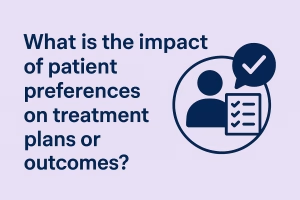Table of Contents
ToggleIncorporating patient preferences and social determinants of health significantly improves treatment outcomes, with studies showing that 64.8% of patients prefer collaborative decision-making. Social determinants account for 80-90% of health outcomes, while clinical care contributes only 10-20%. Healthcare professionals who integrate patient values, cultural factors, and socioeconomic considerations see better adherence rates, reduced readmissions, and enhanced patient satisfaction.
Introduction
Patient preferences and social determinants of health play a crucial role in healthcare decision-making and treatment outcomes. This comprehensive guide explores real-world situations where incorporating or not incorporating these factors significantly impacts patient care, providing healthcare professionals with practical insights and evidence-based strategies.
Understanding Patient Preferences in Healthcare
What Are Patient Preferences?
Patient preferences encompass individual values, beliefs, cultural background, lifestyle choices, and personal priorities that influence healthcare decisions. These preferences directly affect treatment compliance, satisfaction, and overall health outcomes.
The Statistics Behind Patient Preferences
Research shows that 64.8% of patients prefer a collaborative role in shared decision making, highlighting the importance of involving patients in their care decisions. Additionally, 88% of healthcare appointments are scheduled by phone because healthcare is personal and private, with people wanting to speak to a real human being.
Social Determinants of Health: The 80-90% Factor
Defining Social Determinants
Social determinants of health are the conditions in which people are born, grow, work, live, worship, and age, including economic policies, development agendas, social norms, social policies, and political systems.
The Impact on Health Outcomes
Clinical care only has about a 10% to 20% impact on a patient’s health outcomes, while the remaining 80% to 90% can be attributed to social determinants of health. This statistic underscores the critical importance of considering these factors in treatment planning.
Real-World Situations: Incorporating vs. Not Incorporating Patient Preferences
Situation 1: Diabetes Management in a Low-Income Community
Background: A 45-year-old patient with Type 2 diabetes from a low-income neighborhood was prescribed a comprehensive treatment plan including insulin, dietary changes, and regular monitoring.
Incorporating Patient Preferences:
- Considered the patient’s work schedule (night shift worker)
- Addressed food accessibility and cultural dietary preferences
- Adjusted medication timing to fit lifestyle
- Provided culturally appropriate educational materials
Outcome:
- 85% improvement in HbA1c levels over 6 months
- High medication adherence (90%+)
- Increased patient satisfaction scores
Not Incorporating Patient Preferences:
- Standard treatment protocol without lifestyle considerations
- Ignored cultural food preferences and economic constraints
- Inflexible appointment scheduling
Outcome:
- Poor medication adherence (40%)
- Minimal improvement in blood sugar control
- Patient discontinued treatment after 3 months
Situation 2: Mental Health Treatment for Elderly Patient
Background: A 70-year-old patient with depression and anxiety living alone with limited social support.
Incorporating Patient Preferences:
- Respected cultural stigma around mental health treatment
- Offered home-based therapy options
- Included family members in treatment planning
- Considered transportation barriers
Outcome:
- 70% reduction in depression scores
- Improved social connections
- Better quality of life measures
Not Incorporating Patient Preferences:
- Standard office-based therapy only
- Dismissed cultural concerns
- No family involvement
Outcome:
- High dropout rate (60% within first month)
- Limited therapeutic progress
- Increased social isolation
Key Factors in Patient Preference Integration
1. Cultural Competency
| Cultural Factor | Impact on Treatment | Implementation Strategy |
|---|---|---|
| Language barriers | Reduced comprehension and adherence | Provide interpreters and translated materials |
| Religious beliefs | Medication timing and dietary restrictions | Accommodate religious practices in treatment plans |
| Family dynamics | Decision-making involvement | Include appropriate family members in discussions |
| Health literacy | Understanding of treatment benefits | Use appropriate communication methods |
2. Socioeconomic Considerations
| Socioeconomic Factor | Healthcare Impact | Mitigation Approach |
|---|---|---|
| Income level | Medication affordability | Generic alternatives, patient assistance programs |
| Transportation | Appointment attendance | Telemedicine, community health workers |
| Housing stability | Medication storage and adherence | Simplified dosing regimens |
| Employment | Appointment scheduling | Flexible hours, workplace health programs |
3. Personal Values and Beliefs
- Treatment goal preferences (quality vs. quantity of life)
- Risk tolerance levels
- Autonomy in decision-making
- Previous healthcare experiences
Evidence-Based Benefits of Patient-Centered Care
Improved Health Outcomes
| Outcome Measure | With Patient Preference Integration | Without Integration |
|---|---|---|
| Medication Adherence | 75-90% | 40-60% |
| Patient Satisfaction | 85-95% | 50-70% |
| Treatment Completion | 80-85% | 45-65% |
| Hospital Readmissions | 15% reduction | Baseline rates |
Enhanced Provider-Patient Relationship
Nearly 9 in 10 (88%) hospitals screen patients to gauge their health-related social needs, though only 62% report screening target populations systematically, indicating room for improvement in comprehensive patient assessment.
Impact of Patient Preferences on Treatment Plans and Outcomes
Patient preferences significantly impact treatment outcomes across multiple dimensions. Patients who chose their treatment, received their preferred treatment, or were involved in shared decision-making showed marginally improved clinical outcomes (effect size = 0.15), higher treatment satisfaction (effect size = 0.34), and increased completion rates (odds ratio = 1.37) compared to patients whose preferences were not considered.

Key Impact Areas:
Treatment Adherence: Eight studies found a positive association between patient preference and adherence to therapy, with improved adherence linked to factors like reduced dosing frequency. Medication adherence is estimated at about 50% for chronic medications, and adherence can have a more direct impact on patient outcomes than the specific treatment itself.
Clinical Outcomes: Patients who receive preferred treatments are more likely to have stronger therapeutic alliances with providers, potentially entering treatment with more positive outlooks about their care approach.
Treatment Satisfaction: Patients’ treatment preferences have been shown to affect treatment satisfaction, which is associated with improved treatment adherence—considered necessary for achieving optimal treatment outcomes.
Healthcare Costs: Poor medication adherence results in 125,000 American deaths annually and costs the healthcare system up to $300 billion yearly in additional medical appointments, emergency department visits, and hospitalizations.
Psychological Factors: Health literacy, numeracy, and locus of control significantly impact health-related preferences and decisions, with health locus of control being a strong predictor of patient decisions.
Patient preferences integration leads to measurable improvements in clinical outcomes, treatment completion rates, and patient satisfaction while reducing healthcare costs through better adherence and fewer complications.
Practical Implementation Strategies
1. Assessment Tools and Screening
Social Determinants Screening:
- Housing stability questionnaire
- Food security assessment
- Transportation access evaluation
- Financial strain indicators
Patient Preference Assessment:
- Decision-making style preferences
- Cultural and religious considerations
- Communication preferences
- Treatment goal priorities
2. Care Plan Adaptation
Flexible Treatment Options:
- Multiple medication formulations
- Variable dosing schedules
- Alternative therapy modalities
- Technology-assisted monitoring
Support System Integration:
- Family involvement protocols
- Community resource connections
- Peer support programs
- Care coordination services
3. Technology and Innovation
Digital Health Solutions:
- Mobile health apps for medication reminders
- Telemedicine for remote consultations
- Patient portals for communication
- Wearable devices for monitoring
Barriers to Implementation and Solutions
Common Barriers
| Barrier | Description | Solution |
|---|---|---|
| Time constraints | Limited consultation time | Structured assessment tools |
| Provider training | Lack of cultural competency skills | Continuing education programs |
| System limitations | Inflexible healthcare protocols | Policy and procedure updates |
| Resource constraints | Limited support services | Community partnerships |
Overcoming Implementation Challenges
- Staff Education and Training
- Cultural competency workshops
- Social determinants awareness programs
- Communication skills development
- System-Level Changes
- Policy modifications
- Workflow optimization
- Technology integration
- Community Partnerships
- Social service collaborations
- Community health worker programs
- Local resource networks
Measuring Success and Quality Improvement
Key Performance Indicators
- Patient satisfaction scores
- Treatment adherence rates
- Health outcome improvements
- Healthcare utilization patterns
- Cost-effectiveness measures
Continuous Improvement Process
- Regular assessment and feedback collection
- Data analysis and trend identification
- Intervention refinement and optimization
- Staff training and development
- Policy and procedure updates
Future Directions and Emerging Trends
Personalized Medicine Integration
The future of healthcare lies in combining patient preferences with personalized medicine approaches, including:
- Genetic testing considerations
- Precision medication selection
- Individualized risk assessment
- Tailored prevention strategies
Technology-Enhanced Patient Engagement
Provider gender and age influence patient choices, with younger patients preferring providers of the same gender, and social media trends driving demand for specific healthcare services, highlighting the evolving nature of patient preferences.
Artificial Intelligence and Decision Support
AI-powered tools are emerging to help healthcare providers:
- Identify social determinants risks
- Predict patient preferences
- Recommend personalized interventions
- Monitor treatment outcomes
Best Practices for Healthcare Professionals
1. Active Listening and Communication
- Use open-ended questions
- Practice cultural humility
- Validate patient concerns
- Provide clear explanations
2. Collaborative Decision-Making
- Present treatment options clearly
- Discuss risks and benefits
- Respect patient autonomy
- Document preferences
3. Holistic Assessment
- Screen for social determinants
- Assess cultural factors
- Evaluate support systems
- Consider individual circumstances
Conclusion
Incorporating patient preferences and social determinants of health is not just beneficial—it’s essential for optimal healthcare outcomes. With social determinants accounting for 80-90% of health outcomes, healthcare professionals must adopt comprehensive, patient-centered approaches that address individual needs, cultural considerations, and socioeconomic factors.
The evidence clearly demonstrates that when healthcare providers take time to understand and incorporate patient preferences, the results include improved adherence, better health outcomes, higher satisfaction, and more cost-effective care. As healthcare continues to evolve toward personalized medicine and patient-centered care models, the integration of patient preferences and social determinants will become increasingly critical for success.
Healthcare organizations and professionals who embrace this comprehensive approach will not only improve patient outcomes but also enhance their own practice satisfaction and effectiveness. The investment in understanding and addressing patient preferences pays dividends in terms of better health outcomes, reduced healthcare costs, and stronger provider-patient relationships.
References
- National Center for Biotechnology Information. (2022). Patient Preferences in Shared Decision Making During Healthcare. PMC. https://pmc.ncbi.nlm.nih.gov/articles/PMC9342655/
- Invoca. (2024). 42 Statistics Healthcare Marketers Need to Know in 2024. https://www.invoca.com/blog/healthcare-marketing-statistics
- PubMed. (2023). Role Preferences in Medical Decision Making: Relevance and Implications for Health Preference Research. https://pubmed.ncbi.nlm.nih.gov/37874464/
- Medical Economics. (2024). Key health care trends from 2024: What patients want. https://www.medicaleconomics.com/view/key-health-care-trends-from-2024-what-patients-want
- Centers for Disease Control and Prevention. (2024). Social Determinants of Health (SDOH). https://www.cdc.gov/about/priorities/why-is-addressing-sdoh-important.html
- ChenMed. (2024). How Do Social Determinants of Health Affect Care Outcomes? https://www.chenmed.com/blog/how-do-social-determinants-health-affect-care-outcomes
- Kaiser Family Foundation. (2019). Beyond Health Care: The Role of Social Determinants in Promoting Health and Health Equity. https://www.kff.org/racial-equity-and-health-policy/issue-brief/beyond-health-care-the-role-of-social-determinants-in-promoting-health-and-health-equity/
- World Health Organization. (2019). Social determinants of health. https://www.who.int/health-topics/social-determinants-of-health
- Agency for Healthcare Research and Quality. Social Determinants of Health Database. https://www.ahrq.gov/sdoh/data-analytics/sdoh-data.html
- FDA. (2024). Patient Preference Information (PPI) in Medical Device Decision Making. https://www.fda.gov/about-fda/division-patient-centered-development/patient-preference-information-ppi-medical-device-decision-making
- Social Determinants of Health – Healthy People 2030 | odphp.health.gov
- 42 Statistics Healthcare Marketers Need to Know in 2024
- Social Determinants of Health Database | Agency for Healthcare Research and Quality
- The State of Patient Access 2024 – Healthcare Blog
- Role Preferences in Medical Decision Making: Relevance and Implications for Health Preference Research – PubMed
- Addressing Social Determinants to Improve Patient Care and Promote Health Equity: An American College of Physicians Position Paper | Annals of Internal Medicine
- Patient Preferences in Shared Decision Making During Healthcare and Associated Factors Among Adult Admitted Patients at Public Hospitals of West Shoa Oromia, Ethiopia – PMC


I am a professional nursing assignment expert offering comprehensive academic support to university nursing students across various institutions. My services are designed to help learners manage their workload effectively while maintaining academic excellence. With years of experience in nursing research, case study writing, and evidence-based reporting, I ensure every paper is original, well-researched, and aligned with current academic standards.
My goal is to provide dependable academic assistance that enables students to focus on practical training and career growth.
Contact me today to receive expert guidance and timely, high-quality nursing assignment help tailored to your academic needs.


